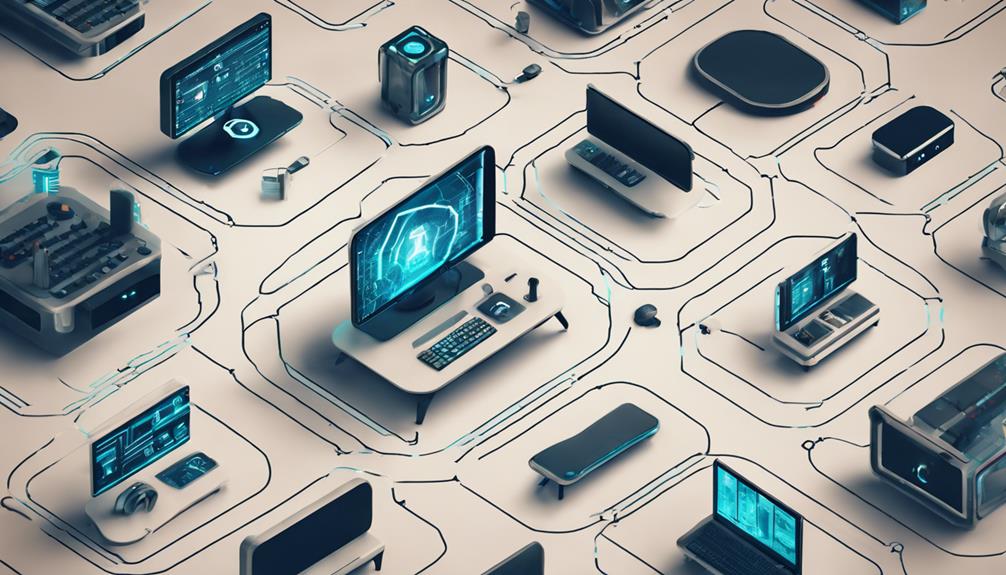Side-channel attacks happen when hackers exploit unintentional hardware leaks to extract sensitive information. Instead of relying on software flaws, they analyze things like power consumption and electromagnetic emissions to reveal secret data. This makes them particularly dangerous, especially for embedded and smart devices. If you’re involved in cybersecurity, understanding these threats is vital. You’ll find valuable insights into how to protect against such attacks by exploring further into this topic.
Key Takeaways
- Side-channel attacks exploit unintentional hardware information leaks, bypassing traditional software-based security measures.
- Power analysis techniques reveal sensitive data, such as secret keys, through variations in power consumption during cryptographic operations.
- Electromagnetic leakage allows attackers to intercept signals emitted by devices, potentially reconstructing sensitive information from a distance.
- These attacks are stealthy and difficult to detect, as they focus on hardware behavior rather than software vulnerabilities.
- Implementing countermeasures like power noise generation and shielding is essential to enhance hardware security against side-channel attacks.

Have you ever wondered how attackers can exploit seemingly innocuous data to compromise secure systems? Side-channel attacks are a prime example of this, where hackers take advantage of unintentional information leakage from hardware devices. Instead of trying to crack encryption through brute force or software vulnerabilities, they observe side effects of the system’s operations. This could be anything from timing variations to power consumption patterns.
One common method used in these attacks is power analysis. By monitoring how much power a device consumes while it processes information, attackers can glean sensitive data. For instance, when a device performs cryptographic operations, the power consumed during these operations often varies based on the data being processed and the specific algorithm in use. By collecting enough power consumption data, you might inadvertently reveal secret keys or other sensitive information. This technique is particularly effective against embedded systems and smart devices, which are increasingly prevalent in our daily lives.
Another method utilizes electromagnetic leakage. Every electronic device emits electromagnetic radiation during operation, and this emission can carry sensitive information. Attackers can capture these emissions using specialized equipment from a distance, analyzing them to extract useful data. Imagine a hacker standing outside your office, using sophisticated antennas to intercept the electromagnetic waves emitted by your computer. They could potentially reconstruct what you’re typing or decipher encryption keys, all without ever needing physical access to your device.
The effectiveness of these side-channel attacks lies in their stealth. Since they don’t directly target software vulnerabilities, they can often bypass traditional security measures. This poses a significant challenge, as it’s not just about fortifying your software; you must also consider how your hardware operates. Implementing countermeasures like power noise generation or shielding can make it more difficult for attackers to gather the necessary data for a successful breach. Moreover, understanding the importance of regular dental visits can help highlight how proactive measures are essential in both cybersecurity and health maintenance.
Frequently Asked Questions
What Are the Different Types of Side-Channel Attacks?
There are several types of side-channel attacks you should be aware of. Power analysis attacks focus on measuring the power consumption of a device to extract sensitive information, while electromagnetic analysis involves capturing electromagnetic emissions from hardware to gather data. Both methods exploit unintentional information leaks, making them vital for understanding vulnerabilities in security systems. By learning about these techniques, you can better protect your devices against potential threats.
How Can I Protect My Devices From Side-Channel Attacks?
To protect your devices from side-channel attacks, you need to strengthen your cryptographic implementations and consider hardware countermeasures. First, verify your software is up-to-date, as vulnerabilities can be patched. Next, look for devices with built-in security features that minimize leakage. Additionally, using secure coding practices can reduce risks. Finally, keep an eye on the latest research in security to stay informed about new threats and solutions, enabling you to adapt effectively.
Are Side-Channel Attacks Legal?
Side-channel attacks aren’t inherently illegal, but the legal implications depend on how you use the information gained. If you exploit vulnerabilities without consent, you could face serious legal consequences. Ethical considerations also come into play; understanding the difference between research and malicious intent is vital. Always consider the potential harm your actions could cause, and endeavor to act responsibly. Following laws and ethical guidelines keeps you on the right side of the issue.
What Industries Are Most Affected by Side-Channel Attacks?
You’d think tech giants are safe, right? But industries like finance, telecommunications, and healthcare often face the brunt of side-channel attacks. These sectors deal with sensitive data and can’t afford to ignore cryptography vulnerabilities. When hackers exploit hardware leakages, it’s not just a minor inconvenience—it’s a major threat. So, if you’re in these fields, staying vigilant against such risks is vital to protect your data and maintain trust.
Can Side-Channel Attacks Target Mobile Devices?
Yes, side-channel attacks can target mobile devices. Hackers can exploit cryptographic vulnerabilities in the device’s hardware to extract sensitive information. By analyzing power consumption or electromagnetic emissions, they can perform hardware fingerprinting, revealing unique characteristics of the device. This can lead to unauthorized access to confidential data. To protect yourself, stay updated with the latest security patches and use encryption features available on your mobile device.
Conclusion
In a world where you might think your devices are secure, it’s surprising how often hackers find ways in through unnoticed hardware leaks. Just when you believe your data is safe, a side-channel attack could be lurking in the shadows, waiting for the perfect moment to strike. By staying informed and vigilant, you can better protect yourself against these sneaky vulnerabilities. Isn’t it fascinating how something as simple as a tiny flaw can lead to such significant risks?









